by Editor | May 31, 2011 | Accomodations, Attractions, Luxury Travel, Restaurants, Video
Article and photos by Elena del Valle
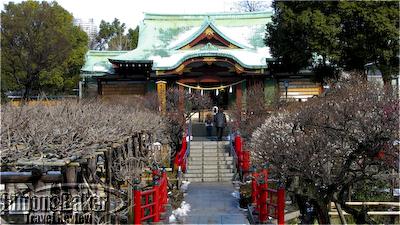
A temple in Tokyo
Earlier this year, before the earthquake hit, I spent a few days in Japan. Although my calendar was overfull it had been years since my last visit to Japan and I couldn’t resist a last minute invitation to the Land of the Rising Sun. Finding a desirable seat on the flights nearly caused the trip to fall apart before it even started. In the end I persevered and with the help of a friendly airline agent everything worked out.
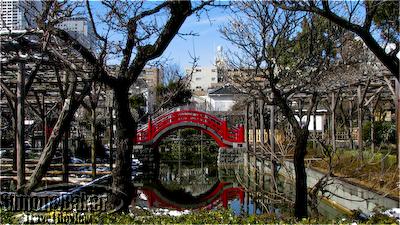
A beautiful garden and bridge in Tokyo
On my arrival at Narita International Airport, I cleared the airport formalities with ease and was thrilled the transfer service driver was waiting for me. He spoke English very well, allowing us to chat during the drive to the Hotel Okura Tokyo (2-10-4 Toranomon, Minato-ku, Tokyo 105-0001, + 81 03 3582-0111, http://www.hotelokura.co.jp/tokyo/en/), where I spent the first three nights in the city. The eleven story contemporary hotel located across the street from the United States Embassy, had 801 rooms, modern facilities, nine restaurants, a fitness center with a swimming pool ($70 per day for hotel guests), spa, ATMs friendly to foreign credit cards, WiFi router for rent (a router compatible with my iPad cost 4,725 yen or about $18 a day at the time) and service oriented English speaking staff. My room was contemporary in style and new looking with a glass enclosed shower, a separate bathtub and a Japanese toilet.
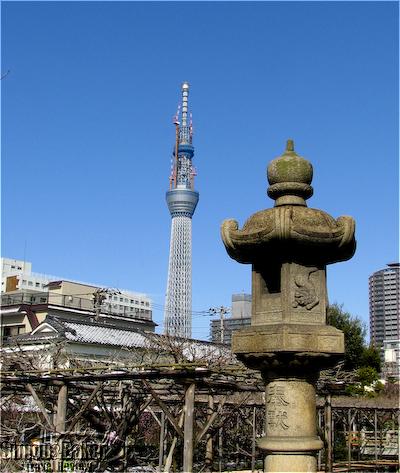
An old versus new contrast with a temple column in the foreground and the Sky Tree in the background
The first day I had breakfast at the Terrace Restaurant, a ground level restaurant facing a snow covered inner courtyard at the hotel. I liked the buffet’s Eastern and Western selection and a delicious tea made from fresh herbs. Later during my stay I sampled some of the items sold at the restaurant’s shop and was quite pleased with the quality.
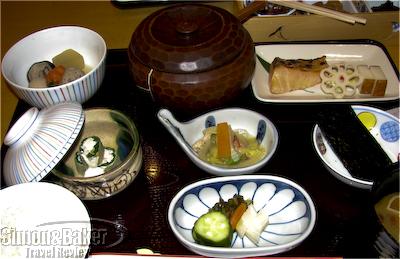
Breakfast at Yamazato restaurant at the Hotel Okura
By far my favorite breakfast in Tokyo was at Yamazato, the hotel’s Japanese restaurant. As I descended the stairs to the restaurant a young man at the entrance welcomed me in English and led me to a table. Even though the two times I was there I was the only Westerner I felt welcome. The wait staff spoke a few words of English making it possible for us to communicate basics. The servers brought me a glass of water when they spotted my vitamin pack. One of them offered to serve me beef or pork in case I didn’t want fish but what is a Japanese breakfast without fish?
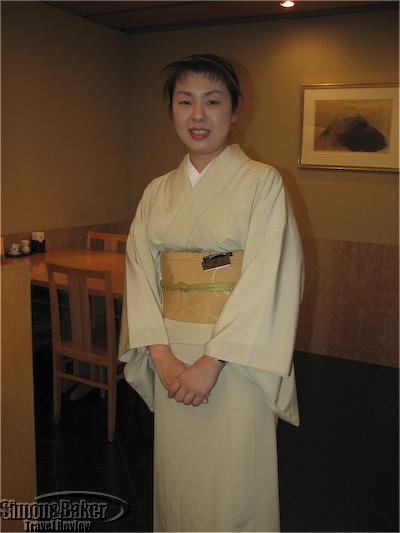
A waitress at Yamazato restaurant at the Hotel Okura
The Japanese breakfast came in a bento box with rice, fish dish (sauteed yellowtail, octopus), hearty and especially flavorful miso soup, pickled vegetables, steamed vegetables, bamboo shoots, mushroom, eggs, and a couple of unidentified dishes. Everything was delicious.
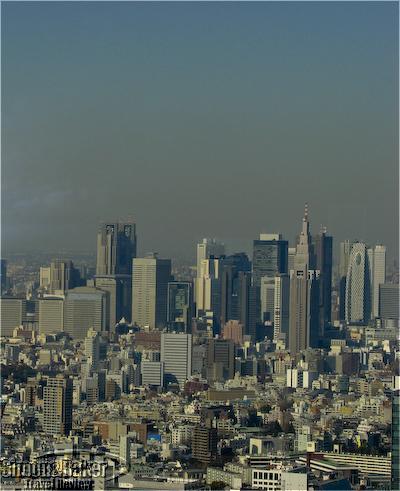
The Tokyo skyline from the Mori Building
In the same way that New York is associated with the Big Apple, Sumiyo, our tour guide, explained, visiting the city of Tokyo can be thought of as exploring an egg. Architecture Guide in Tokyo, a color brochure in English, explained the ways in which Tokyo is like an egg; a handy map on the back pointed to the salient architectural areas of the city. The 284-acre imperial palace appeared in the lower right side of the egg. The inside of the brochure contained a series of descriptions of architectural areas of note within the city based on the egg simile: Omelet-rice for semi-European before 1945, Bacon egg for Western styles before 1945, Atsuyaki tamago Japanese style before 1945, Egg sand for modern style between 1945 and 1975, Boiled egg for plain style between 1976 and 1985, Scrambled egg for post modern style between 1986 and 1995, and Pudding after 1996.
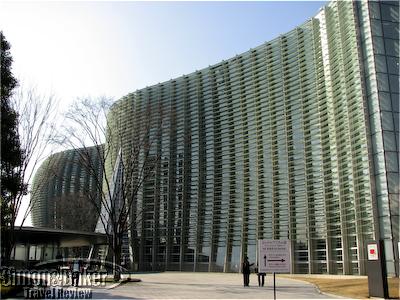
The National Art Center in Tokyo
During the next two days, we would be seeing several neighborhoods within the “egg” of Tokyo, a metropolis of 13 million souls established in 1868 following the collapse of the shogun government. We began across town from our hotel with a visit to Edo Kiriko in Hanashyo (http://www.hanashyo.com), a 60 year old family owned fine cut glass store and workshop. The traditional Japanese home where it was located had such narrow spaces only four or five people could enter at one time. During our visit we watched the owner and his young apprentices engrave and hand polish each colorful piece without using hydrochloric acid at a ground floor workroom, and we saw the finished cut glass pieces on display in a small upper floor showroom. Hanashyo sold Kome-tsunagi, Itokiku-tsunagi and Tama-ichimatsu, three registered proprietary designs. We also visited a second showroom where glass cutting classed were offered. We were invited to experience cutting glass for ourselves for a couple of minutes each. It was fun.
One of my favorite experiences in Japan was a special abbreviated daytime performance of four geishas at Hisago-an restaurant (in Japanese only, http://kaiseki-hisagoan.com/course_hisagoan.html/). The geishas we saw that day normally only perform at the restaurant at night. Three of them danced, one sang briefly and the most senior one played a banjo like instrument. Following the dance they demonstrated one of the games they play while entertaining guests and, with the help of an interpreter, answered questions. In their company we took a rickshaw ride from the restaurant to Senso-ji (http://www.senso-ji.jp/about/index_e.html ), a nearby Buddhist temple, and strolled around the Asakusa area and its well known outdoor shopping arcade next to the temple. It seemed everyone was staring at us until someone explained it was the geishas rare daytime stroll that drew public attention.
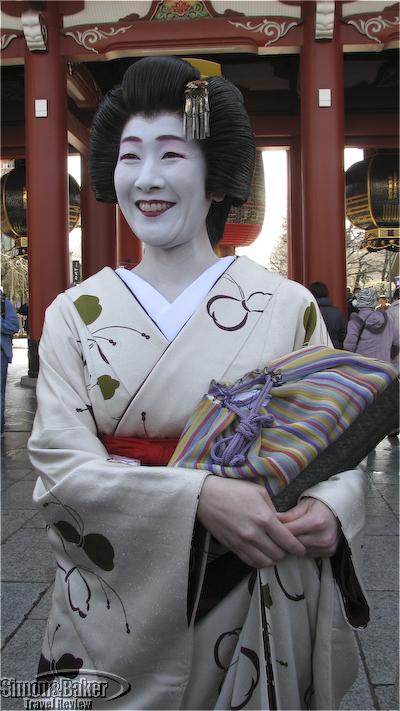
One of the geishas who walked with us
From there we drove to Omotesando Ukai-tei (http://www.ukai.co.jp/english/omotesando/index.html), a French influenced restaurant in a shopping mall where we had a Tenderloin Lunch Course, a refined and delicious four-course lunch. During the meal we noticed fine Ercuis French silverware and wood chopsticks, Reidel glassware, and embroidered napkins. We were served Dermotte non vintage Champagne followed by Assorted Appetizers, Roasted Bamboo Shoots, Shellfish Cream Soup, Ukai Beef Tenderloin Pan Fried and Dessert. Although we didn’t have a view from our seats the bar area had pretty city views. The restaurant, part of a chain of restaurants and museums, housed an exhibition space with a perfume bottle collection and a dessert lounge with Art Nouveau ceilings and lacquered pillars.
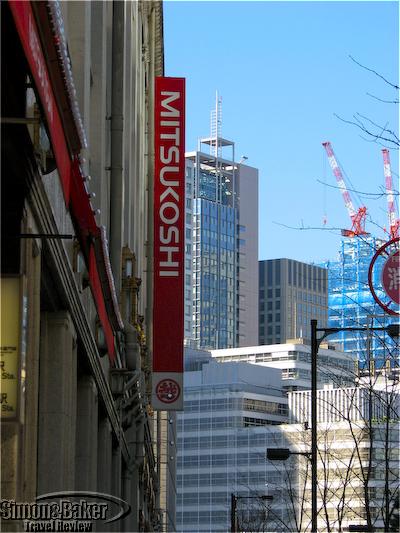
The main location of Mitsukoshi Nihonbahi, one of Tokyo’s most exclusive department stores
Following lunch we walked around the Omotesando and Aoyama areas. We visited the Espace Louis Vuitton Tokyo (Louis Vuitton Omotesando Building 7F 5-7-5 Jingumae, Shibuya-ku, Tokyo 150-0001, +81 03 5766 1088, www.espacelouisvuittontokyo.com) which was hosting French artist Xavier Veilhan; and the Ukiyo-e Ota Memorial Museum of Art (http://ukiyoe-ota-muse.jp/index-E.html), housing a collection of Ukiyo-e Japanese woodblock art.

Strawberries for sale in the food hall of the Mitsukoshi Nihonbahi store
The next day after my delightful Japanese breakfast I was ready to face the cold again. This time we visited the main location of Mitsukoshi Nihonbahi store (Nihombashi Muro-machi 1-4-1, Chuo-ku, Tokyo 103-8001, +81 03 3241 3311, http://www.mitsukoshi.co.jp/store/fcs/english/1010/index.html), one of the most exclusive department stores in Tokyo. We arrived just in time to watch the opening ceremony at 10 a.m. during which the store staff welcomed arriving guests with deep bows. My favorite area of the beautiful and well stock multi-story store was the lower level where the food shops were located. It was filled with all types of hard to find eatable items including pastries, seafood, meat, chocolate, vegetable and fruit delicacies. I could have spent at least another hour exploring the food halls and tasting samples.
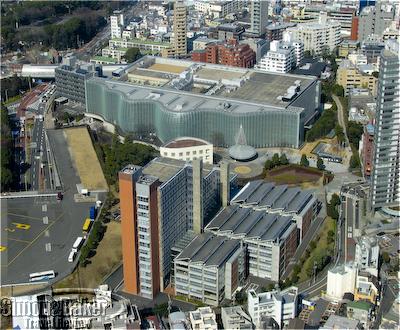
Another view of the city from the Mori Tower
From there we went to the Mori Tower in Roppongi Hills for an outstanding skyscraper view of Tokyo (http://www.roppongihills.com/tcv/en/ ). That morning we visited Tokyo Midtown, walked by the Mori Art Museum (http://mori.art.museum/eng/index.html) dedicated to promoting “art and life in the 21st century,” and the Suntory Museum of Art (http://www.suntory.com/culture-sports/sma/) dedicated to challenging conventional attitudes to the classification of art to reveal its beauty.
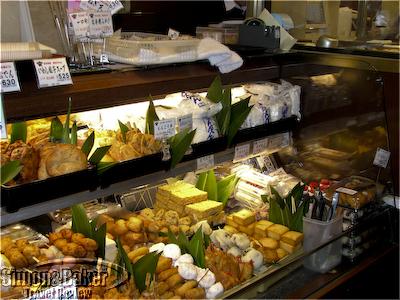
A display at the food hall of the Mitsukoshi Nihonbahi store
Lunch was at Rakutei (+81 3585 3743), a tiny family owned restaurant in Akasaka. Although there was no sign on the building to indicate the existence of a restaurant once inside we were welcomed in Japanese and invited to enter. We sat at a small counter facing an open cooking area. At first it looked like a sushi bar but we soon discovered it was not. An elderly man and his assistant were busy preparing the meal while the man’s wife placed dinnerware in front of us and offered us beverages. We had warm sake and a delicious tempura lunch served two bites at a time until we surrendered.

The interior of the National Art Center in Tokyo
After a lightning fast visit to the National Art Center (http://www.nact.jp/english/index.html ), a 14,000 square meter large venue for temporary art exhibitions, we ended the day with a stroll in a Ginza district shopping street. Ginza, meaning place where money is made in Japanese, is one of the most popular and most expensive tourist shopping areas of Tokyo, our tour guide explained.
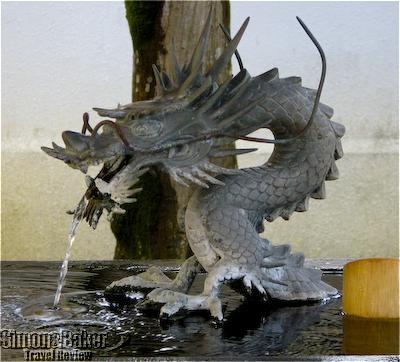
A dragon water fountain in Shuzenji Village
After breakfast the next morning we drove to Shuzenji, a two and a half hour drive from Tokyo, for an overnight stay at Yagyu-no-sho, a traditional Japanese ryokan. By the time we had a tour of the traditional style ryokan, found our rooms and explored the area by the ryokan it was time for dinner and we retreated indoors.
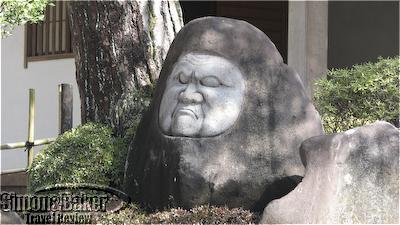
A stone head at the entrance to the Shuzenji Temple
The next day our visit to a local pottery artist’s shop was canceled providing an unexpected opportunity to stroll through Shuzenji Village, exploring the shops and visiting the interior of the Shuzenji Temple, a rare treat before our return home.
by Editor | May 23, 2011 | Ecotourism
By Chester Godsy
Photos by Chester Godsy and Joni Johnson-Godsy
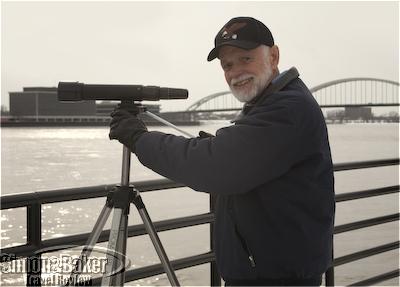
Bob Motz of Bald Eagle Safaris
While visiting the Quad Cities we met with naturalist Bob Motz who offers local Bald Eagle Safaris. Bob filled us in on many of the interesting facts about eagles on our drive to an eagle viewing location. He told us he had a number of locations where he would take customers depending on their interests. Our interest on this trip was to get some pictures of eagles and to stay out of the cold weather as much as possible as temperatures were below 0 degrees Fahrenheit.
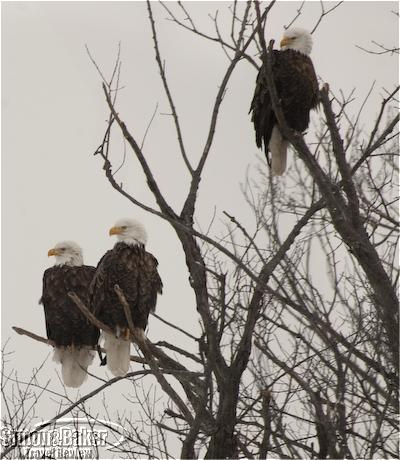
Eagles roosting
Bob provided us with some top notch spotting scopes that would go from x15 to x45 magnification and a training session on how to use them. When we arrived at the location he had selected we saw, spread across numerous trees, about two dozen eagles. There was a mixture of fully mature eagles (these could be identified by their white heads) and juvenile eagles (under five years of age). We watched the eagles with the spotting scopes and took pictures from the warmth of Bob’s car. We were between 25 and 75 yards from the eagles at all times.
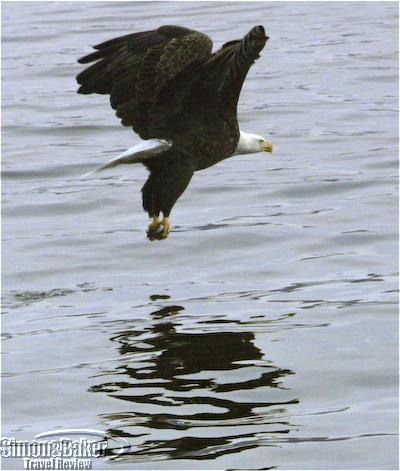
Eagle in flight
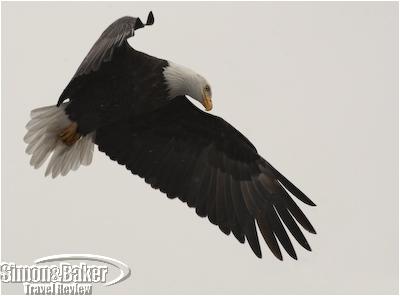
Coming in for a landing
On more than one occasion I had an eagle in full view with a spotting scope where I could clearly see the yellow eye of the eagle blinking. After our time with Bob we were really glad we started our eagle viewing with Bob’s Eagle Safaris (Eagle Safaris by Bob Motz, 2535 River Heights Drive, Rock Island, Illinois 61201, +1 (309) 788-8389, eaglemotz@aol.com) because of all we learned about the eagles before setting off to try eagle viewing by ourselves.
by Editor | May 16, 2011 | Accomodations, New Articles, Restaurants
By Elena del Valle
Photos by Gary Cox
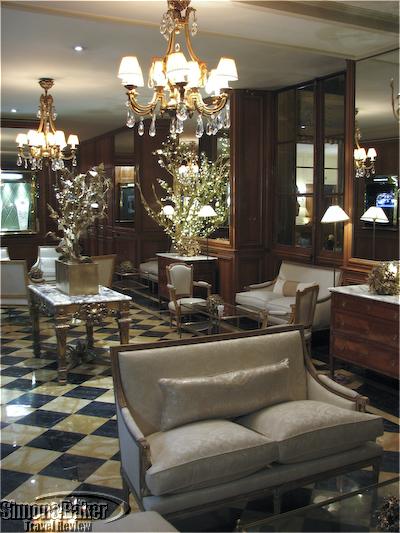
The common areas in Hotel de Crillon
Location, location, location. There is much truth to the saying in a city like Paris, France. Being in a good neighborhood means easy access to many of the attractions that make Paris one of the most alluring cities in the world.
From a tourist perspective the Place de la Concorde is a great location. While the Place itself is attractive it offers the added advantage that within walking distance or a short taxi ride from the Place there are many tourist points of interest like Tuilleries Gardens, Rue de Rivoli, Louvre Museum, Place Vendome, Place de la Madeleine and Champs Elysees Avenue as well as shopping venues and gourmet restaurants.
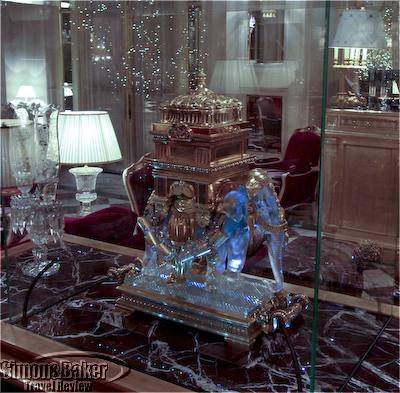
The Baccarat crystal elephant in the salon outside Les Ambassadeurs
On the Place, the Hotel de Crillon, part of a project commissioned in 1758 by Louis XV, became a private residence and was converted to a hotel in 1909. Over time the hotel has been the temporary home of United States Presidents Herbert Hoover, Theodore Roosevelt and Richard Nixon, Emperor Hirohito of Japan, Reza Shah Pahlavi of Iran, King George V of England, King Juan Carlos and the queen of Spain, Madonna, and Elizabeth Taylor among others. The historic building is to this day a luxury hotel. We stayed there during a holiday trip to the City of Lights.
For those who need to combine business with pleasure the hotel, located across the street from the United States Embassy, is in central Paris. Although the facade was under renovation and there was scaffolding covering the front of the building, inside there were many features that made the hotel worth a stay for business and leisure travelers. Our suite had a living area with a desk that was convenient for personal and business meetings and there was excellent internet connectivity for both of our computers.
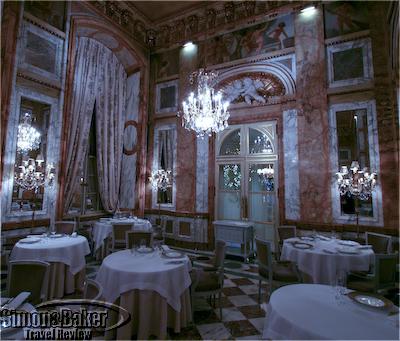
The dining room at Les Ambassadeurs
Over the years the marble filled historic building has been well maintained. Our spacious and handsome Presidential Suite looked onto Rue de l’Arcade and a building that may have been part of the embassy complex. We liked the well known entrance from the Place de la Concorde and another more discreet entrance on Rue de l’Arcade leading to Rue Saint Honore, a popular shopping street. As guests we had access to a fitness center, two restaurants and a bar within the hotel; we could also walk for exercise and dine at one of the myriad restaurants within a short distance of the hotel.
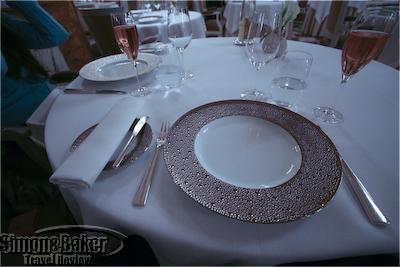
A place setting at Les Ambassadeurs
For years Les Ambassadeurs, the hotel’s gourmet restaurant, has stood out among the thousands of dining venues of the city. Its beautiful dining room and prized location on the Place de la Concorde have been among its attractions along with talented chefs and capable restaurant staff. During our stay at the hotel we dined at Les Ambassadeurs, which had undergone a change in management and chef, to rediscover the restaurant.
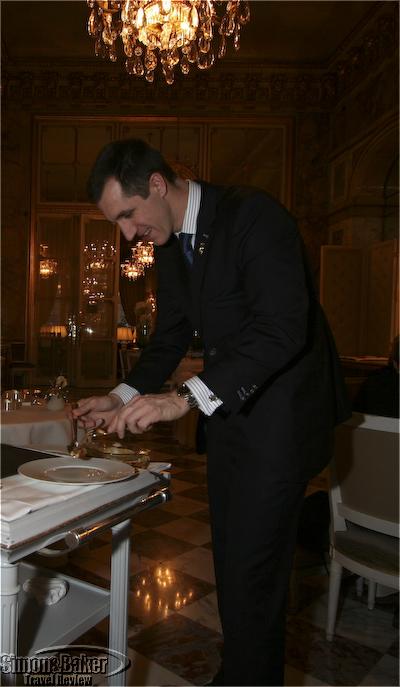
Pierre Jung, the restaurant manager at Les Ambassadeurs
We were pleasantly surprised to see Pierre Jung, the new manager and a familiar face. We knew him from his time at the well known Senderens restaurant in the nearby Place de la Madeleine. Christopher Hache, the promising new young chef, who we met briefly that day, also had experience at Senderens (and as it was formerly known Lucas Carton). Our delicious and well served tasting menu was a success. We plan to return to the restaurant when next we are in Paris.
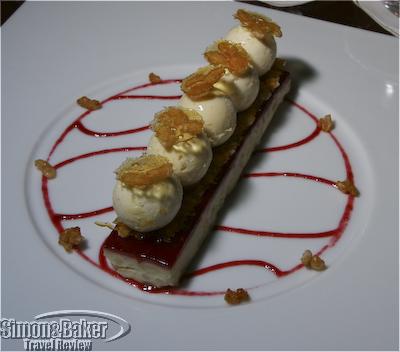
Dessert at Les Ambassadeurs
We thoroughly enjoyed our most recent stay at the Hotel de Crillon, especially our Presidential Suite and indulgent meal at Les Ambassadeurs. Visit the Simon & Baker Travel Review for information about the restaurant Les Ambassadeurs and Hotel de Crillon in Paris, France.
by Editor | May 9, 2011 | Restaurants
By Elena del Valle
Photos by Gary Cox
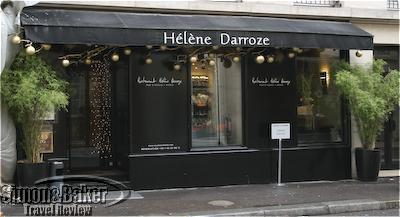
The entrance to Hélène Darroze
For years we had been fans of Chef Hélène Darroze, an up and coming chef with an adventurous touch. It had been nearly four years since our last visit and we wondered what was new at her Latin Quarter restaurant in Paris, France. When we visited Paris most recently we made time to sample the restaurant’s Lunch and Tasting menus.

A pre-appetizer sliced at our table was a favorite
We discovered a very different restaurant from the one we used to visit. Where there used to be an a la carte and special menus now there were only two basic dining options. There was a Lunch Menu for 52 euros or 65 euros with two glasses of wine, and a Degustation Menu priced at 125 euros or 175 euros with four glasses of wine.
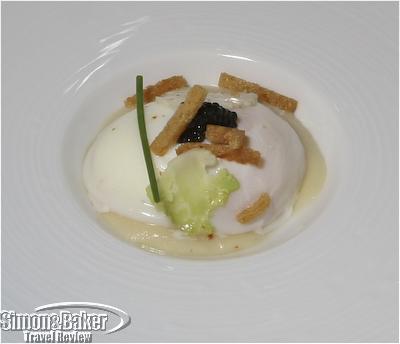
French caviar with cauliflower mousse from Britanny
The first day we dined there we had the Lunch Menu: Le caviar de France mousseline de chou-fleur de Bretagne en gelée iodée, tartare de noix de coquilles Saint-Jacques de Port en Bessin au corail d’oursin; Le homard bleu cuit à la nacre,royale de potimarron, miettes de châtaigne, cappuccino de Parmesan Reggiano; Le chipiron de ligne de Saint-Jean de Luz fine raviole aux verts de blette et olives Taggiasche, chorizo, réduction à l’encre perlée d’huile d’olive, émulsion d’ail rose; Le foie gras de canard des Landes de chez Dupérier grillé au feu de bois, betteraves glacées, jus de riquette à l’estragon; La sole de petit bateau filet tartiné de limequat confit, sudachi, salsifis et coquillages, émulsion à la citronnelle; Le cochon d’Ibérico Bellota Carré et pluma, chou de Bruxelles, pomme Rubinette et chasselas de Moissac caramélisés, jus de déglaçage; L’ananas, la vanille et la noix de coco dans une version sucrée de la pina collada; and Le chocolat Manjari de Madagascar ganache, crème brûlée au calamansi confit, crumble au cacao.
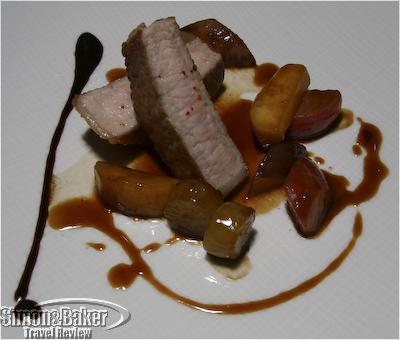
A favorite Bellota pork dish
On the last day of the year we had the Tasting Menu: Le caviar de France mousseline de chou-fleur de Bretagne en gelée iodée, tartare de noix de coquilles Saint Jacques de Port en Bessin aux coraux d’oursin (Caviar from France iodized Brittany cauliflower mousseline, tartar of Saint-Jacques scallops from Port en Bessin with sea urchin); Le homard bleu cuit à la nacre, royale de potiron, miettes de chataîgne, capuccino de parmesan Reggiano (Blue lobster slightly seared, winter squash royale, chestnut crusts, Parmigiano Reggiano cappuccino); Le chipiron de Saint-Jean-de-Luz fines ravioles aux verts de blette et olives Taggiasche, chorizo, réduction à l’encre perlé d’huile d’olive, crème d’ail rose (Line caught calamari from Saint-Jean de Luz ravioli with chard and Taggiasche olives, chorizo, ink reduction with olive oil, pink garlic emulsion); Le foie gras de canard des Landes de chez Dupérier grillé au feu de bois, betteraves glacées, jus de roquette à l’estragon (Dupérier’s duck foie gras grilled on wood fire, glazed beets, riquette jus with tarragon); La sole de petit bâteau filet tartiné de limequat confit, sudashi, salsifis et coquillages, émulsion à la citronnelle (Sole fillet, spread with confit limquat, sudachi, salsify and shellfish, lemon grass foam); Le chevreuil filet rôti au poivre long, côtelette juste saisie, chou de Bruxelles, pomme Rubinette et chasselas de Moissac caramélisés; La poire Comice pochée, panacotta parfumée au gingembre confit, biscuit clafoutis, granité à la poire (Pina colada coconut crisps, lemon jelly, Bombay curry, Tahitian vanilla ice-cream); and Le chocolat Manjari de Madagascar ganache, crème brûlée au kalamansi confit, crumble au cacao (Manjari chocolate from Madagascar ganache, confit Calamansi crème brûlée, cocoa crumble).
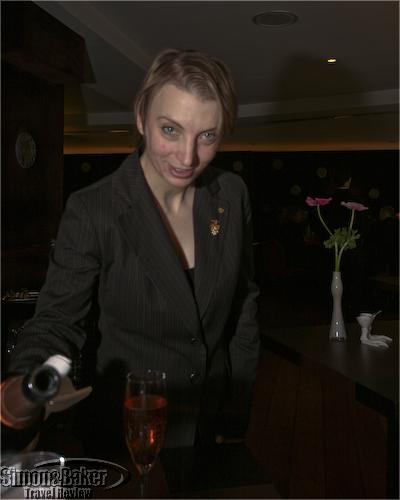
The sommelier pouring our champagne
Céline Strenta, the sommelier, selected three young wines to accompany our meal Pacherenc du Vic Bihl 2009, Vouvray sec 2007 “Le Mont” Domaine Huet and Bergerac 2008 “Clos des Verdot” David Fourtour. We liked the red best.
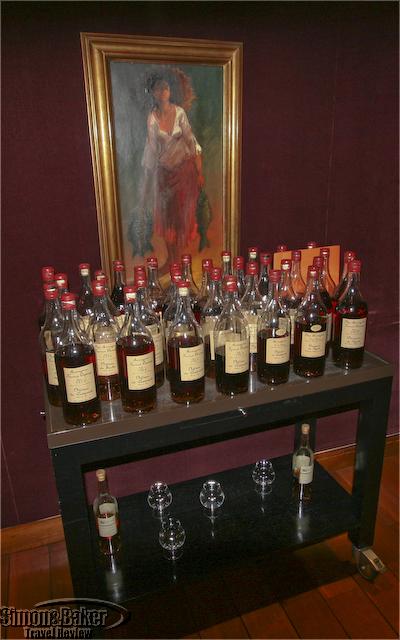
The armagnac cart
Both times the upstairs gourmet dining room (the restaurant offered two additional dining venues on the ground floor) at the restaurant Helene Darroze where we had lunch was near full. The meals were satisfying, well prepared and well served. The English speaking staff that looked after us were helpful and pleasant and and the overall dining experience was worth repeating. Restaurant Hélène Darroze, 4 rue d’Assas, 75006, Paris, France, Telephone + 33 42 22 00 11, www.helenedarroze.com, Email reservation@helenedarroze.com.
by Editor | May 2, 2011 | Luxury Travel
By Elena del Valle
Photos by Gary Cox
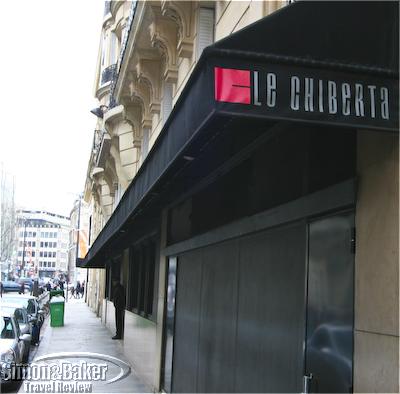
A street view of Le Chiberta
It was lunch time on a quiet winter day when we first discovered Le Chiberta. As we entered the restaurant through twin glass doors we encountered welcoming faces. A young lady took our coats and within minutes we were seated at a comfortable corner table near the entrance, next to a window.
Although the simple decor in black and charcoal gray revealed little about the food we might expect we had high hopes for the restaurant, owned by Guy Savoy, one of the city’s best known chefs. In the past, we had dined at Restaurant Guy Savoy, the chef’s eponymous restaurant, with quite positive results and were looking forward to trying out Le Chiberta, a budget friendly alternative.
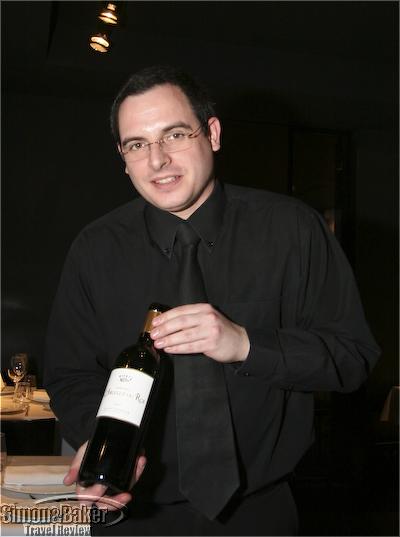
Our server Francois
We were the first guests to arrive at the restaurant with capacity for 80 situated in a quiet small street very near the famed Champs Elysees in Paris, France. Slowly others from near and far arrived. We shared our section of the dining room (there were several sections) with three tables of two and were looked after mainly by Francois, an English speaking server who was friendly and very helpful.
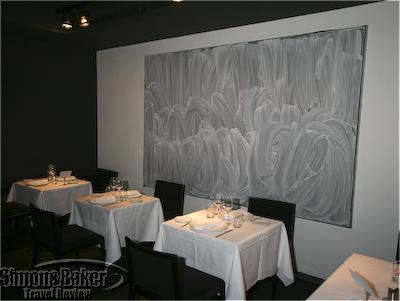
The artwork added texture to the decor
At our table the only decorations were the meal service and a simple steel colored salt and pepper set. While we awaited our lunch we observed the interior décor, which was somewhat similar to the familiar Guy Savoy sister restaurant. It was the work of Jean-Michel Wilmotte and was meant to emulate an informal club style. Across from our table there was an over large oil painting. We noticed bottle-lined walls in the adjoining dining room and hallway. These were understated and juxtaposed with contemporary works of art by Bertrand Lavier and Gérard Traquandi.
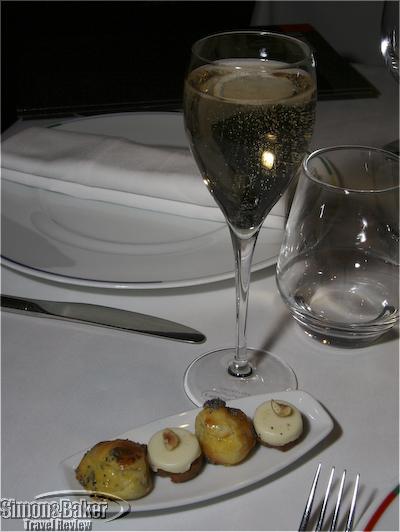
Champagne and amuse bouche bites
We began our lunch with a glass of Laurent Perrier Champagne. Soon two amuse bouche bites appeared and shortly after that a bread basket with two types of bread and Saint Malo seaweed butter arrived. We left our selections in the hands of the chef who delivered a well balanced and refined meal. He served: Amuse bouche Crème de carotte à la citronnelle-gingembre gambas rôtie aux épices douces; Terrine de foie gras de canard artichaut et figue royale de foie gras chutney de kumquat et mangue; Filet de daurade royale à la plancha écrasée de potimarron, salade amère jus au sarrasin; Suprême de colvert rôti, cuisse confite fricassée d’épinards, artichauts et trompettes de la mort jus salmis; Brie truffé et mascarpone salade de mâche; Tout clémentine; and Le cube chocolat-café. It was served with white: Beaune Longbois 2008 Domaine Berthelemot; Condrieu Chauson 2007; and Domaine du Monteillet, S Montez wines; and red wines: Château L’Argilus du Roi 2007 Saint-Estèphe and a dessert wine, Maury Mas Amiel vintage 2008.
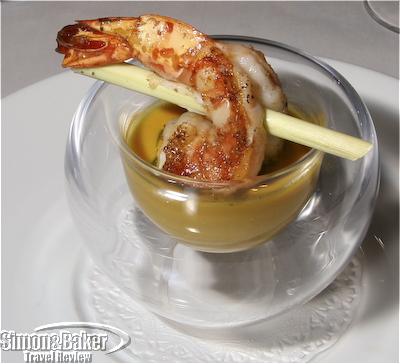
The prawn and ginger carrot soup
The first course, a favorite and we learned after we finished every bite, one of the restaurant’s specialties, featured a carrot ginger soup in a glass bowl with a single prawn skewered by a lemon grass stick. The next course was foie gras with artichoke and fig in the middle, accompanied by warm foie gras cream served in a small glass with kumquat and mango chutney. There was additional chutney with a tiny bite of sweet tuille to accompany the dish; warm toast were served with it. It was served with a citrusy light white wine.

The dorade with mashed pumpkin
Dorade fish (a favorite) served with mashed pumpkin and a foam came next. It was accompanied by an oaky white wine. Wild duck from the forest served very rare with marvelous mushrooms and a little spinach came next. It was accompanied by a lovely 2007 Saint Estephe red. Truffled brie with home made truffle filling served with black truffle shavings and a salad of baby mache with a vinegar dressing was the perfect follow up to the wild duck. A tangerine palate cleanser followed the cheese and a wonderful chocolate cube and coffee ice cream dessert completed the meal. It was served with a velvety red dessert wine.
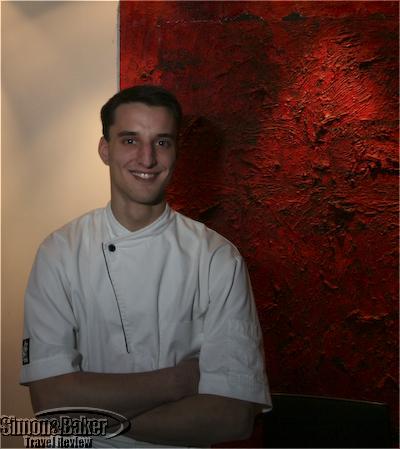
The chef at Le Chiberta the day we visited the restaurant
It can be challenging to find a satisfying meal without spending a fortune in that very touristy area of Paris. Le Chiberta, established in 2004, combined a desirable location with excellent food and attentive service in a pleasant setting. Kudos to Chef Guy Savoy and Stéphane Laruelle, Le Chiberta’s executive chef.
Le Chiberta (Le Chiberta, 3, rue Arsene Houssaye, 75008, Paris France, Telephone +33 1 53 53 42 00, Fax +33 1 45 62 85 08, www.lechiberta.com, chiberta@guysavoy.com) is now part of very our short list of options anytime we are in the mood for well a prepared yet unpretentious meal in area of the Champs Elysees.














































